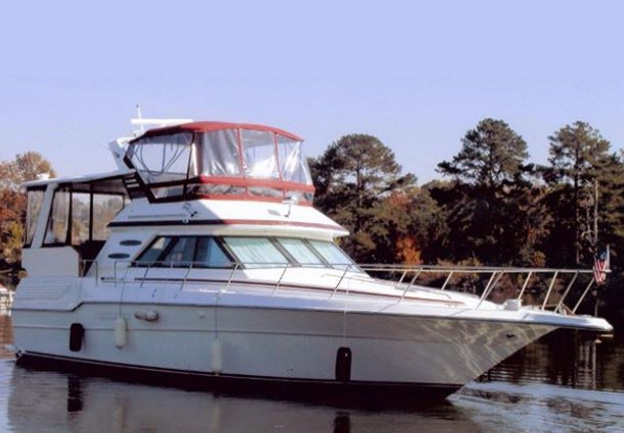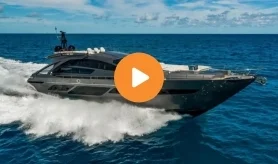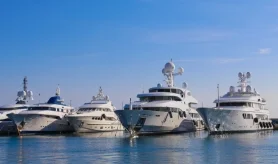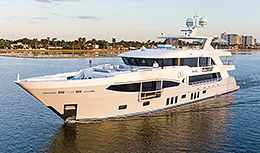- Alaskan Yachts
- Azimut Yachts
- Back Cove Yachts
- Beneteau Yachts
- Benetti Superyachts
- Bertram Yachts
- Boston Whaler
- Broward Yachts
- Buddy Davis Sportfish
- Burger Yachts
- Cabo Yachts
- Catamarans
- Carver Motoryachts
- Center Console
- Chris-Craft Yachts
- Cruisers Yachts
- DeFever Trawlers
- Dufour Sailboats
- Fairline Yachts
- Feadship Yachts
- Ferretti Yachts
- Formula Yachts
- Fountaine Pajot Cats
- Grady-White
- Grand Banks Trawlers
- Hargrave Yachts
- Hatteras Yachts
- Hinckley Picnic Boats
- Horizon Yachts
- Hydra-Sports
- Intrepid Boats
- Jarrett Bay Sportfish
- Jeanneau Yachts
- Kadey-Krogen Trawlers
- Lazzara Yachts
- Lekker Boats
- Luhrs Sportfish
- Marlow Yachts
- Maritimo Yachts
- Marquis Yachts
- Mazu Yachts
- McKinna Motoryachts
- Meridian Yachts
- Midnight Express
- MJM Yachts
- Mochi Craft
- Neptunus Motoryachts
- Nordhavn Trawlers
- Nordic Tugs
- Numarine Yachts
- Ocean Alexander Yachts
- Ocean King
- Offshore Yachts
- Outer Reef
- Oyster Sailing Yachts
- Pacific Mariner Yachts
- Palmer Johnson Yachts
440 Sea Ray Aft Cabin
![]()

Source: Jack Hornor, Mad Mariner Magazine
Even Many Years Later, This Sea Ray Makes an Ideal Coastal Cruiser or Home Away From Home
There just may be some truth in the old adage “you get what you pay for.”
When everything is clean, new and shiny at a dealer’s showroom or a boat show, it can be difficult, even for the most seasoned boater, to identify the details that account for considerable price differences between boats that are similar in size, accommodations and amenities. Although after 10 or more years in service, design and construction shortcomings are almost certain to be more apparent in any boat, few volume-production boat builders can match Sea Ray Boats when it comes to standing up to the test of time and service.
|
Overall Length |
45.92 Feet |
|
Maximum Beam |
13.92 Feet |
|
Maximum Draft |
2.92 Feet |
|
Displacement/Weight |
23,000 Pounds |
|
Fuel Capacity |
400 Gallons |
|
Water Capacity |
130 Gallons |
|
Top Speed Range |
15-24 Knots |
Sea Ray’s first 40-plus-foot aft-cabin model was introduced in 1986. Known as the 410 Aft Cabin, it had an overall length of 40 feet and 7 inches. The following year, the addition of a bow pulpit resulted in an increase in length to 43 feet and 6 inches, and the model was renamed the 415 Aft Cabin. Apparently the marketing department remeasured the boat with the swim platform and found it to be 45 feet and 11 inches. The model name was again changed to the 440 Aft Cabin with the 1989 model year. The 440 number stuck until the model went out of production in 1991.
Don’t be confused by the name changing, as the 410, 415 and 440 all share the same basic hull that, without appendages, measures 40 feet and 7 inches and has a maximum beam of 13 feet and 11 inches. Draft and displacement differ slightly depending on engines and equipment, but the manufacturer’s specifications indicate the draft at 3 feet and 2 inches, and displacement at 23,000 pounds.
More than 15 years after production ended, Sea Ray’s 440 Aft Cabin has proven to be well worth her higher cost and remains in high demand on the used-boat market.
The hull of the 440 is soundly built with solid-fiberglass laminates and no core materials. Strength and stiffness is provided by longitudinal and athwartship stiffeners that are fiberglassed in place. The finish of these attachments is quite good, and the sharp, rough fiberglass edges common to more moderately priced boats are non-existent on the Sea Ray. The superstructure is constructed of fiberglass laminates, with a balsa-wood core used in the deck and cabin top for stiffness. The deck and hull are joined in a shoebox-fashion with screws and sealant. This is the one of the few disappointments of the 440’s construction. Without the use of adhesive compounds or through bolts, the deck-to-hull joint is bound to weaken over time by normal flexing of the boat. The inevitable hard docking or encounter with a piling is also much more likely to cause damage. Leaks along the joint and crazing of surface finishes are a common result of normal use.
For light, ventilation and an emergency exit from the aft cabin, Sea Ray installed a large opening port in the transom that is an excellent safety feature but can also be a troublesome source of leaks. Although these leaks may be temporarily stopped or slowed down with a little well-placed silicone sealant, the solution is removal, cleaning and resealing, a job that usually requires two people and the better part of a day to complete.
The method of construction of the 440 allows reasonable access for inspection, repair, adding and servicing equipment that is considerably better than most boat of this vintage.
Three separate areas provide for lounging, entertaining and operating the 440, and all are efficiently laid out, resulting in a clean and stylish appearance.
With the exception of the early 410 models, there is a bow pulpit forward surrounded by a sturdy stainless steel rail that allows convenient anchor storage and provides a handy, secure area for handling dock lines. The forward cabin top is low profile, and unobstructed, it can easily accommodate two or three sunbathers. Moving aft along the cabin house, the side decks are wide, unobstructed and secure with a stainless rail well above normal knee height and handrails along the side of the flybridge.
The aft deck is fully covered by a permanent, factory-installed rigid fiberglass top. Owners with removable clear-plastic curtains have enclosed most aft-deck areas. With normal service, these enclosures can be expected to last 10 or more years before needing replacement, at which time, the cost will range from $2,500 to $5,000, depending on materials chosen. The aft deck easily accommodates two comfortable deck chairs and a small table. A sliding door from the aft deck leads to the main salon. A gate and ladder aft lead to the swim platform, and to the port side, steps forward lead to the flybridge.
The flybridge is positioned atop the main salon. Reaching it is easy, and it is large enough to accommodate the skipper and several guests. The control console has complete instruments for both engines, although there is no convenient charting space available. This may be a moot point in a day when electronic-charting instruments can be added for well less than $1,000, and paper charts are used for confirmation and backup. As the flybridge is the only steering station, most owners have added canvas tops and clear-plastic enclosures for protection and comfort in inclement weather. Properly maintained fabrics will last 10 to 12 years and clear plastics six to eight.
As is the case with all aft-cabin yachts, Sea Ray’s 440 is a cabin-comfort-oriented vessel with primary emphasis placed on arrangement and appointments inside. After all, most boaters interested in this type of vessel are looking for one that will most likely be their home away from home. The 440 should not be a disappointment in this regard.
The general layout, with a stateroom forward, followed by the galley, main salon and aft stateroom, remained the same throughout production, although there were slight modifications in cabin arrangements over the years.
On most models the forward stateroom features a diagonal, offset double berth, although some early 410 and 415 models feature over/under single bunks along the port side of the cabin. In addition, there is a good-sized hanging locker and lots of storage. Further aft to starboard is a head with small shower. To starboard is a large galley with plenty of storage and counter space. Standard galley equipment included an upright refrigerator, three-burner stove, microwave oven and even a blender built into the counter top. The drawback to these installations is that they all operate on A.C. current, which means you must be plugged into shore power or run the auxiliary generator to use the equipment. On 410 and 415 models, there was a four-person dinette opposite the galley that was eliminated in favor of more space in the main salon and a wraparound lounge on the 440 model.
The midship main salon is open and comfortable, with plenty of light and nearly 360-degree visibility through large forward and side windows. There is a couch or settee that converts to an extra double berth and an entertainment console for TV and stereo.
The master stateroom is aft. It features a centerline queen-sized berth, more storage and hanging locker space than you likely had in your first apartment and a head with separate shower stall. Many of the 415 models were equipped with a stacking washer and dryer that were shoehorned into a starboard locker in the master stateroom. This was an idea that didn’t work because it took up space that was much more valuable for storage, not to mention that service, removal and replacement is impossible without tearing apart cabinet and joiner work.
I think it’s fair to say that most of these models were originally powered by twin, freshwater-cooled, 340-horsepower MerCruiser gasoline engines. Although 350-horsepower Crusader gas engines were an option in the early models, diesel-engine options were offered throughout production, and I would estimate about 20 percent were built with the diesel engines that were, in most cases, the Caterpillar model 3208.
Engines are installed below the main salon, along with an auxiliary generator forward of them. Considering the size of the boat, access for service and maintenance of the machinery is general good.
If speed is your thing, this will not be the boat for you, but if you’re willing to settle for a comfortable, leisurely ride to your destination, you will be quite satisfied with the 440’s performance. With gas engines the boat achieves a cruising speed of 15 knots and will top out at about 24 knots. With the diesel-engine option, it sees cruising speed increase to a respectable 20 knots, while top-end performance remains about the same as for the gas engines. In either case, the 17-degree deadrise of the hull makes for a smooth ride, easy control and good directional stability.
If this sounds like the type of boat that would interest you, the good news is there are a reasonable number of boats available. In my research I was able to find 12 offered for sale between Massachusetts and Florida, and two of the 12 were diesel-engine models. The bad news may be in the price of diesel-engine models. Those who want these will likely have to pay a hefty premium.
The quality and workmanship that separates Sea Ray Boats from less-expensive volume-production boats is apparent throughout the 440, from electrical wiring to joiner work to fiberglass finish. And, while the 440 shows a few design and construction shortcomings, after 10 or more years of service, they occur with considerably less frequency than on less-costly production models. This, combined with the fact that Sea Rays have consistently been among the leaders in resale value, makes the 410, 415 and 440 all excellent choices whether your plans call for extended coastal cruising or simply a place to get away for the weekend.



